As a unique phenomenon of soil erosion in the granite-red-soil hilly area of southern China,
Benggang has seriously affected agricultural development and regional sustainable development. However, few studies have focused on the driving factors and their interactions with
Benggang erosion at the regional
[...] Read more.
As a unique phenomenon of soil erosion in the granite-red-soil hilly area of southern China,
Benggang has seriously affected agricultural development and regional sustainable development. However, few studies have focused on the driving factors and their interactions with
Benggang erosion at the regional scale. The primary driving forces of
Benggang erosion were identified by the factor detector of the geographical detector, and the interaction between factors was determined by the interaction detector of the geographical detector. The 10 conditioning driving factors included terrain, hydrology, vegetation, soil, geomorphology, and land use.
Benggang erosion in Ganzhou City principally occurred in the granite-red-soil forest hill, characterized by an elevation below 400 m above sea level, slope below 25° of concavity, a distance to the gully less than 500 m, a vegetation coverage of 40–60%, and an average rainfall erosivity of 6400–7000 MJ·mm/(hm
2·h·a). The key driving factors for
Benggang erosion were rainfall erosivity, elevation, and land use. Moreover, the interaction of any two factors was stronger than that of a single factor, and the nonlinear enhancement factors had a stronger synergistic effect on erosion. Therefore, the comprehensive influence of many factors must be considered when predicting and preventing
Benggang erosion.
Full article





